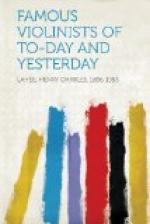It seems that the people of Hamburg did not show much enthusiasm over the young artist, for he was unable to arrange a hearing, and, having exhausted his funds, he returned to Brunswick in the time-honoured manner of unsuccessful artists,—on foot. Spohr’s experience seems to have produced upon him the same effect that many aspiring young players have since felt, viz., that he had better go on with his studies. He accordingly presented a petition to the Duke of Brunswick asking for means to carry out his desires. The duke was pleased with him, and not only gave him a place in his band, but also agreed to pay his expenses while he studied with one of the most eminent teachers of the day.
Neither Viotti nor Ferdinand Eck could receive him as a pupil, but by the advice of the latter, young Spohr was placed under his brother, Franz Eck, who was then travelling in Germany. With Franz Eck an agreement was made by the duke, under which Spohr should travel with him, and study en route. During the continuance of this agreement Spohr practised sometimes ten hours a day, and being so constantly with his teacher he made great progress. On his return to Brunswick he was appointed first violinist in the duke’s band, and the following year he once more undertook a concert tour on his own account, travelling through Saxony and Prussia, and meeting with great enthusiasm.
While in Russia he met Clementi and Field, and he was presented with a most valuable Guarnerius violin by an enthusiast. This instrument he lost while on the way to France, where he intended to make a concert tour. Just before entering Goettingen the portmanteau which contained the violin was taken from the coach, and owing to the delays of officialism it was never recovered. The thieves had been seen with the booty in their possession, but in order to arrest them it was necessary to travel some nine miles for the necessary warrant and officer. In the meantime they had disappeared, as thieves occasionally do.
In 1805 Spohr was appointed concert-master in the band of the Duke of Gotha, and while holding this position he met, wooed, and wedded the Frauelein Dorothea Scheidler, an excellent harp player, who for many years afterwards appeared with him in all his concerts, and for whom he wrote many solo pieces as well as some sonatas for violin and harp. In view of this important step the following description of Spohr’s personal appearance may be interesting: “The front of Jove himself is expressed in the expansive forehead, massive, high, and broad; the speaking eyes that glance steadfastly and clearly under the finely pencilled arches of the eyebrows, which add a new grace to their lustrous fire; the long, straight nose with sharply curved nostrils, imperial with the pride of sensibility and spiritual power; the firm, handsome mouth, and the powerful chin, with its strong outlines melted into the utter grace of oval curves. In its calmness and repose, in its subdued strength and pervading serenity, it is the picture of the man’s life in little.” Spohr seems to have been somewhat attractive.




